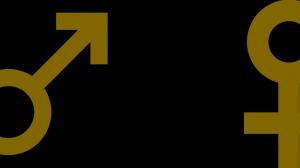The way that we categorize our world is typically in a binary standard. As humans, it makes everything easier to understand if we put it under labels. For gender, we think there’s either male or female. For sexuality, we expect people to either be heterosexual or homosexual. And when something doesn’t necessarily fit into that category or expectation, it makes us uncomfortable.
For this post, I’ve decided to put together the terms Binary, Non-Binary, Bisexuality, and Biphobia because gender and sexuality are never just one or the other, they are presented on a spectrum.
As I said above, gender is often viewed as a binary opposition, but there are people who do not always identify as one or the other or as a combination and identify as non-binary or genderqueer. Typically, non-binary or genderqueer folks use the pronoun they/them because it does not identify them as a man or woman. You should never assume what someone’s pronouns are if they haven’t told you and it is better to respectfully ask what someone would like you to call them.
Non-binary is not a new category of identifying oneself either and it’s not “just a phase.” Hundreds of societies have three or more genders including the Mahu in Hawaii, the Femminiello in Italy, and the Malmuk in Egypt. People who don’t identify as male or female in these societies are typically seen as spiritual leaders. For example, the Mahu are people that are born either sex but embody gender roles of both genders, they hold sacred roles and are valued members of society as educators, and often lead ancient traditions. Unfortunately, while third genders in some societies are values, many people are still persecuted for this and it is important to recognize that.
Moving onto bisexuality, just like gender, sexuality is on a spectrum. Not everyone is 100% straight or 100% gay, there are people who do fall in between. Just like non-binary people, bisexual people are not “going through a phase” or secretly straight or secretly gay. If someone identifies as bisexual and they are dating someone of the opposite sex, they are still bisexual. If someone identifies as bisexual and they are dating someone of the same sex, they are still bisexual.
Biphobia is the belief that this identity is just someone “going through a phase,” and unfortunately even members of the LGBTQ+ community discount bisexual identities telling them to “just pick a side.”
Being an ally to the LGBTQ+ community means recognizing these identities and not discounting them just because it is something foreign to you.
You don’t have to understand exactly what someone’s identity is to respect it.
Other Useful Resources:
Understanding Non-Binary People: How to be Respectful and Supportive
A Map of Gender Diverse Cultures (uses some problematic language, so be aware of that but still helpful to see how different every culture is).
